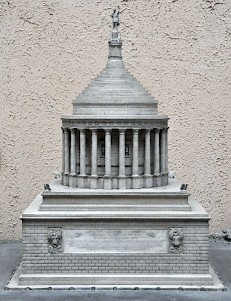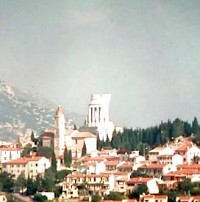Tropaeum Augusti (La Turbie)
Q747588La Turbie: town in France, near Monaco, known for a monument dedicated to the emperor Augustus.

Augustus' victory monument at La Turbie, just north of Monaco, was built in 5 BCE, and commemorates the submission of the tribes in the western Alps. Seen from the shore, it is high up the mountains, which come very close to the Mediterranean Sea on this place. It comes as no surprise that (according to the Peutinger Map) the Romans originally called the site In Alpe Maritima. Later, it was called Tropaeum Augusti (or Tropaeum Alpi), from which the modern name is derived.
The conquest had been achieved in campaigns in 25, 16, and 15 BCE, which had culminated in the conquest of Vindelicia and Raetia (modern Switzerland and Germany south of the Danube) by Augustus' stepsons Drusus and Tiberius. The event was also commemorated by the poet Horace, who devoted Ode 4.4 to these victories. Once the western Alps had been pacified, Rome had a direct route from northern Italy to Caesar's conquests in Gaul and the Rhine. Cities like Lyon, Aventicum, Augusta Raurica, and Vindonissa completed the project.

The monument itself was almost fifty meters high. It consisted of a square podium, twelve meters high, on which the inscription was written, flanked by two Victories. The second tier, accessible by stairs, consisted of a roofed circular colonnade. Between the twenty-four columns, one could see statues of various commanders. On top of a stepped cone, the visitor could see the statue of Augustus. The gilded parts must have been visible from a great distance and may have served as a beacon for ships.
The momument was made of local stone; the quarry, which is about 600 meters northwest of the monument, is still in use. Today, the cone and the statue are missing; the monument is now thirty-five meters high. The inscription can no longer be read, but it can be reconstructed because it is quoted by Pliny the Elder:note
|
IMP CAESARI DIVI FILIO AVG
PONT MAX IMP XIIII TR POT XVII SENATVS POPULVSQVE ROMANVS QVOD EIVS DVCTV AVSPICIISQVE GENTES ALPINAE OMNES QVAE A MARI SVPERO AD INFERVM PERTINEBANT SVB IMPERIVM P R SVNT REDACTAE GENTES ALPINAE DEVICTAE
|
||||||||||||||||||||||||||||||||||||||||||||||||||||
|
To imperator Caesar Augustus, son of the deified Caesar,
pontifex maximus, fourteen times imperator, in the seventeenth year of his tribunicial powers, the Senate and People of Roman [dedicated this] because under his guidance and auspices, all Alpine nations who live between the Adriatic and Tyrrhenian Seas, were submitted to the Empire of the Roman people. Conquered tribes:
|
The monument used to mark the boundary between Italy and the province of Alpes Maritima. In the twelfth century, the monument served as fortress, and parts of the dome were used to build houses. In 1705, king Louis XIV ordered its destruction; the stones were reused to build a nearby church. The monument was restored in the 1920s and 1930s.